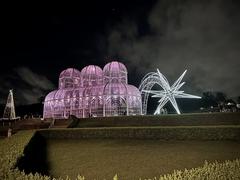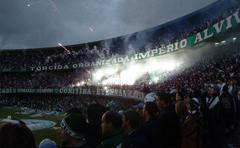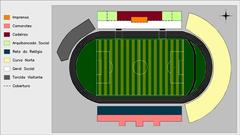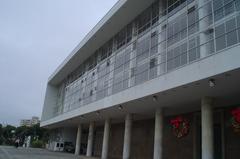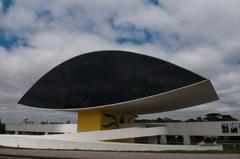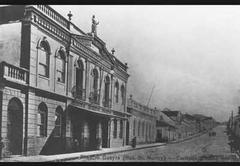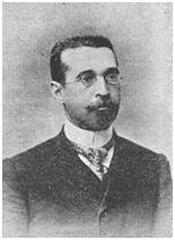
Museu de História Natural Capão da Imbuia: Visiting Hours, Tickets, and Guide to Curitiba Historical Sites
Date: 03/07/2025
Introduction
Nestled in the Capão da Imbuia neighborhood of Curitiba, Brazil, the Museu de História Natural Capão da Imbuia stands as a beacon of scientific discovery and environmental education. Situated within one of the last remnants of the critically endangered Araucaria Forest, this museum is dedicated to documenting, conserving, and showcasing the region’s extraordinary biodiversity. It is both a hub for scientific research and a welcoming destination for families, students, and tourists, offering free admission and a rich array of indoor and outdoor experiences (Museu de História Natural Capão da Imbuia).
Whether you are a nature enthusiast, a history buff, or simply seeking a tranquil escape within Curitiba, this comprehensive guide covers everything you need to know—from visiting hours and admission details to highlights of the museum’s collections, educational programs, and conservation initiatives.
Table of Contents
- Introduction
- Historical Development and Mission
- Conservation and Scientific Collections
- Visitor Information
- Highlights of the Museum Experience
- Frequently Asked Questions (FAQ)
- Conclusion and Visitor Tips
- References
Historical Development and Mission
Founded to document and protect the natural heritage of Paraná, the Museu de História Natural Capão da Imbuia has its roots in the early 20th-century movement to conserve Brazil’s unique flora and fauna. Its location within a preserved forest fragment was a strategic decision, linking scientific study directly with a living ecosystem in urgent need of conservation (Museu de História Natural Capão da Imbuia).
Over the years, the museum has evolved into a national reference for zoological collections and research, hosting laboratories, a specialized library, and serving as a “fiel depositário” (official depository) for genetic heritage samples. It is recognized not only as an essential cultural institution but also as a custodian of biodiversity data vital for local, national, and global conservation (Museu de História Natural Curitiba).
Conservation and Scientific Collections
Araucaria Forest: Conservation in Action
The museum’s grounds protect a significant remnant of the Araucaria Forest (“Floresta com Araucária”), which has been dramatically reduced by land conversion and urbanization. Visitors can explore the “Caminho das Araucárias,” an elevated walkway with interpretive panels that highlight the ecosystem’s ecological importance and ongoing conservation challenges (Prefeitura de Curitiba).
The surrounding Bosque Capão da Imbuia is a municipal conservation unit, home to centenarian trees and diverse wildlife, offering a living laboratory for ecological research and a tranquil urban refuge (Bendito Guia).
Zoological and Botanical Collections
The museum houses thousands of specimens representing the region’s biodiversity, including mammals, birds, reptiles, amphibians, insects, and plants. Its herbarium contains over 30,000 botanical specimens, while the zoological collections include rare and type specimens critical for taxonomic research (Museu de História Natural Capão da Imbuia).
Digitized records are accessible through platforms like SiBBr, enhancing collaborative research and public transparency. The collections serve as a foundation for biodiversity monitoring, conservation planning, and education.
Environmental Education and Engagement
A core mission of the museum is environmental education. Permanent and temporary exhibitions—such as the “Ecossistemas Brasileiros” dioramas and the immersive “Espeleo Experiência – a Vida Nas Cavernas”—invite visitors to explore Brazil’s diverse ecosystems and the importance of their conservation (Muralzinho de Ideias).
The museum offers workshops, guided tours, and interactive activities for students, families, and community groups, fostering environmental awareness and stewardship. The adjacent wildlife rehabilitation center (CAFS) provides care for rescued animals, supporting both animal welfare and environmental law enforcement (RIC.com.br).
Visitor Information
Hours and Admission
- Opening Hours: Tuesday to Sunday, 9:00 AM to 5:00 PM (last entry at 4:45 PM). Closed Mondays and select holidays (Museu de História Natural Capão da Imbuia - Horários).
- Admission: Free for all visitors. Donations are welcome to support conservation and education.
Accessibility and Guided Tours
- The museum is wheelchair accessible, with ramps, adapted restrooms, and partially accessible outdoor trails (Bendito Guia).
- Guided tours are available in Portuguese, with English tours by prior arrangement. Group tours require advance booking.
Special Events and Workshops
- The museum regularly hosts temporary exhibitions, environmental campaigns, and educational workshops. Examples include the “Projeto Meros do Brasil” exhibition and the “Fauna Paranaense Ameaçada de Extinção” display.
- Check the official website or social media for schedules and updates.
Directions and Nearby Attractions
- Address: Rua Benedito Conceição, 407 – Capão da Imbuia, Curitiba, Paraná.
- Transportation: Accessible by public bus lines and taxi; limited on-site parking.
- Nearby Attractions: Jardim Botânico de Curitiba, Oscar Niemeyer Museum, and Curitiba’s historic city center are all within easy reach.
Highlights of the Museum Experience
Permanent Exhibition Halls
- Hall of Brazilian Fauna: Over 400 taxidermied specimens, including jaguars, maned wolves, and toucans, displayed in realistic dioramas (Prefeitura de Curitiba).
- Hall of Brazilian Flora: Extensive botanical collections and engaging displays on the ecological role of the Araucaria Forest.
- Entomology Collection: Butterflies, beetles, and native bees, with a focus on pollinator conservation.
- Paleontology: Fossils from the Permian period, including ancient tree trunks and reptiles (Museu de História Natural Capão da Imbuia - Paleontologia).
Outdoor Attractions
- Capão da Imbuia Woods: 39,000 square meters of preserved forest with interpretive trails.
- Tree of Araucaria: A living symbol of Paraná’s natural heritage.
- Vivarium: Live native reptiles and amphibians in naturalistic habitats.
Interactive and Family-Friendly Features
- Children’s Discovery Area: Hands-on activities, specimen handling, and educational games.
- Digital Experiences: Interactive screens and occasional augmented reality features.
Visitor Amenities
- Café, gift shop, picnic areas, and accessible restrooms are available on-site.
Frequently Asked Questions (FAQ)
What are the visiting hours?
Tuesday to Sunday, 9:00 AM to 5:00 PM; last entry at 4:45 PM.
Is admission free?
Yes, entry is free for all visitors.
Are guided tours offered?
Yes, in Portuguese (and in English with advance notice).
Is the museum accessible?
Yes, most facilities and some trails are accessible to visitors with disabilities.
Can I take photographs?
Photography is permitted except in select areas (e.g., vivarium).
Are pets allowed?
No, to protect wildlife and exhibits.
What else can I visit nearby?
Consider the Botanical Garden, Oscar Niemeyer Museum, and the city center.
Conclusion and Visitor Tips
The Museu de História Natural Capão da Imbuia is more than a museum—it is a vibrant center for environmental education, scientific discovery, and cultural enrichment in Curitiba. Its free admission, accessible facilities, and diverse programming make it a top destination for anyone wishing to explore Paraná’s natural and historical legacy. For the best experience, visit during weekday mornings, wear comfortable shoes, and check the official website for current exhibitions and events.
Plan your visit today, and don’t forget to download the Audiala app for audio-guided tours and updates on Curitiba’s many cultural attractions.
References
- Museu de História Natural Capão da Imbuia
- Museu de História Natural Capão da Imbuia Official Website
- Prefeitura de Curitiba - Museu de História Natural Capão da Imbuia
- MHNCI Official Site
- Curitiba Tourism Information
- Bendito Guia
- Muralzinho de Ideias
- RIC.com.br
- Curitiba Cultural





